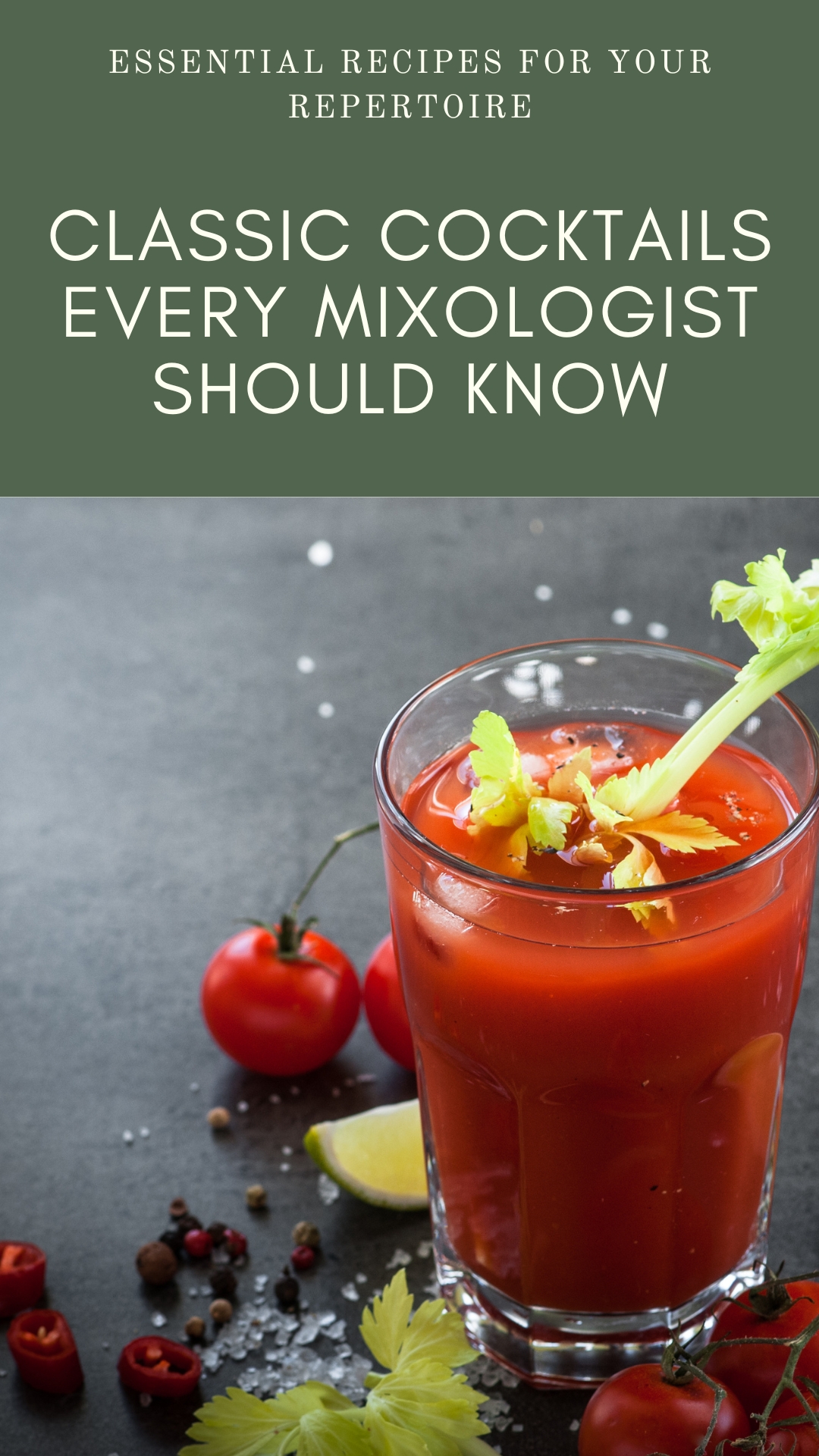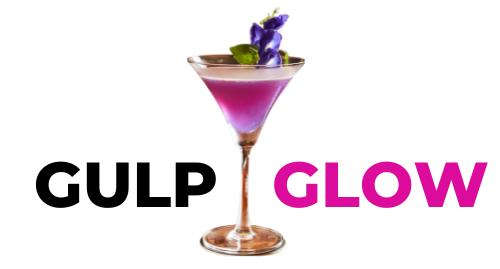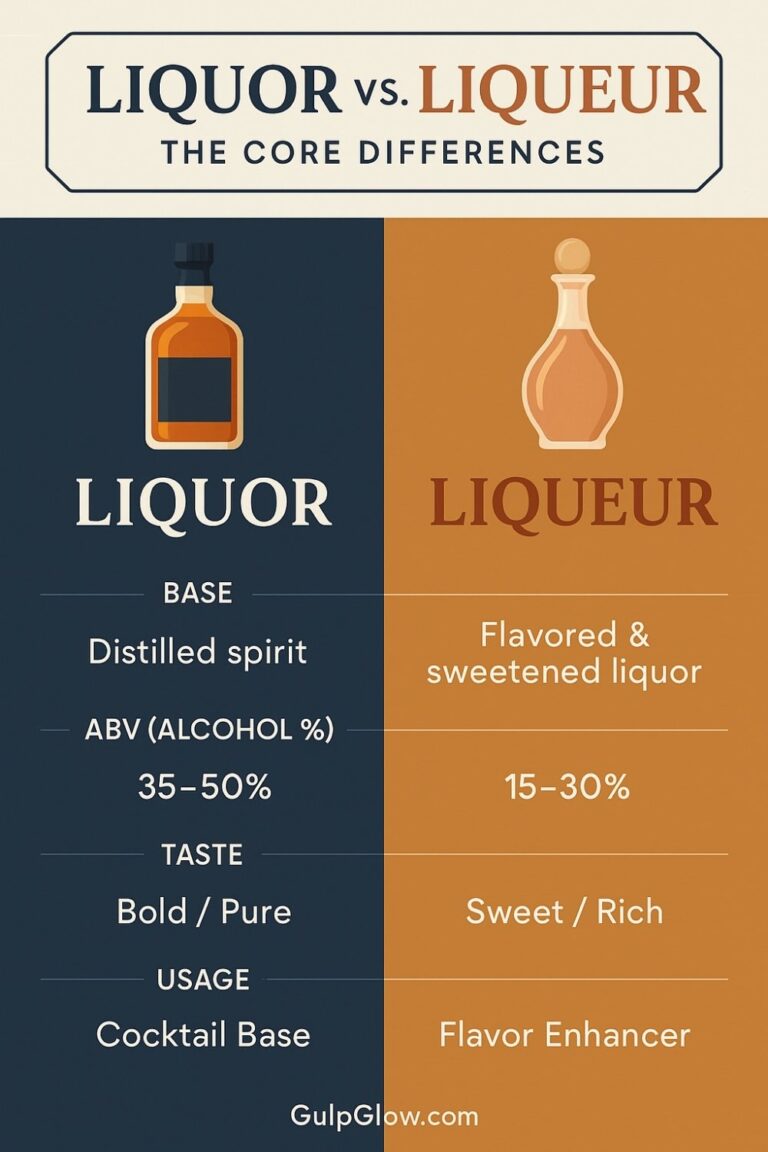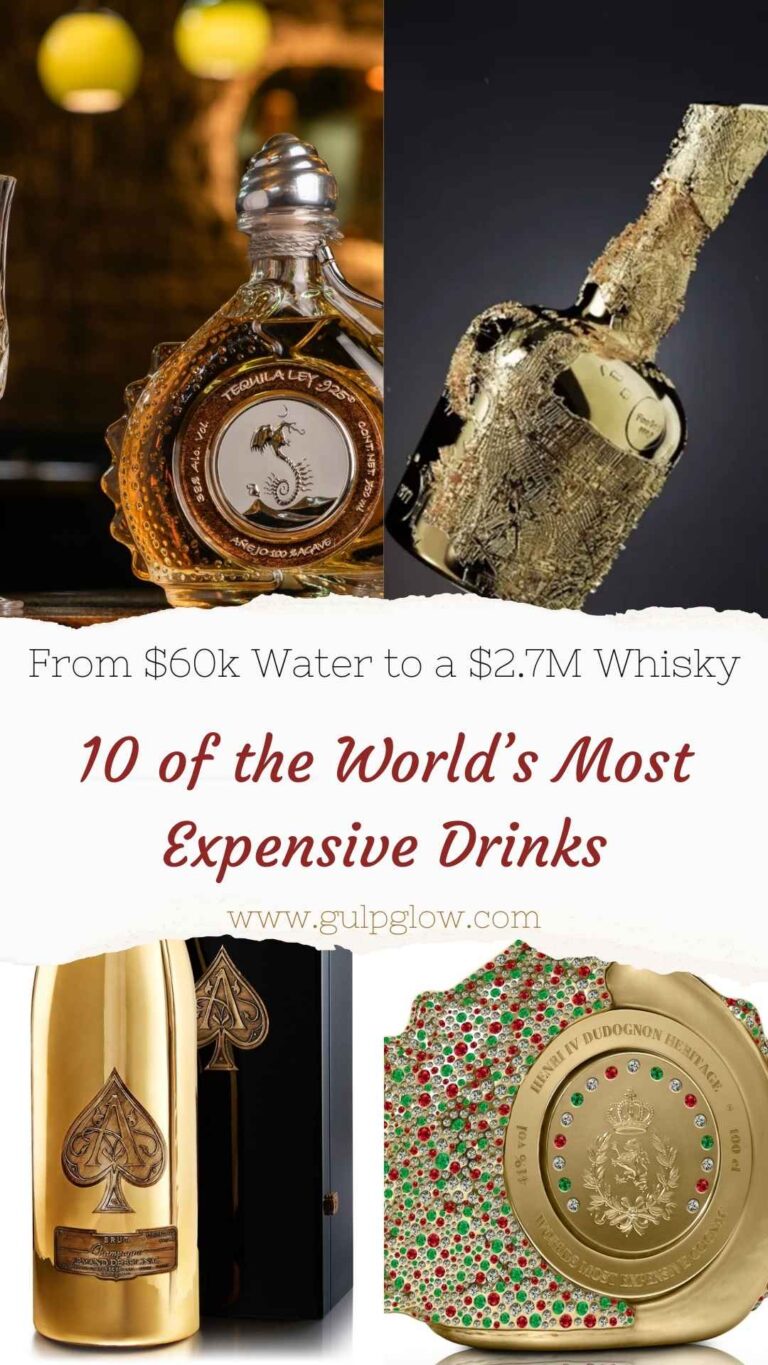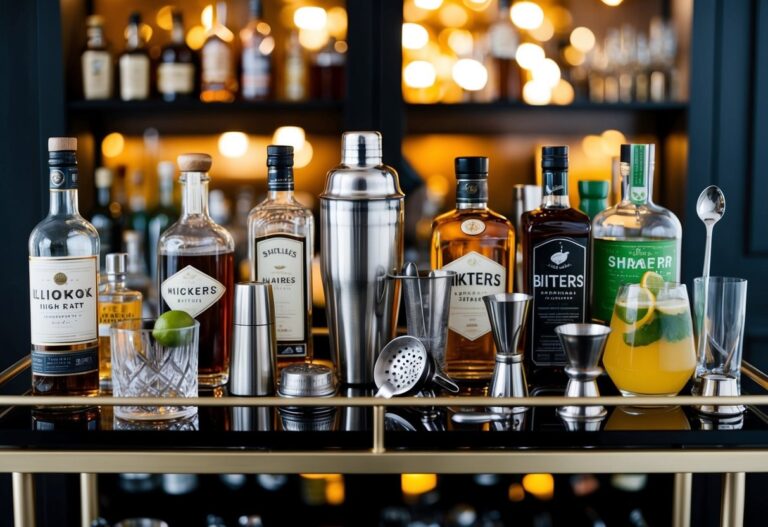Classic Cocktails Every Mixologist Should Know: Essential Recipes for Your Repertoire
Mixing cocktails at home can be a fun and rewarding hobby, whether you’re a beginner or an experienced bartender. The world of classic cocktails is vast, filled with time-tested recipes that have delighted drinkers for decades. Knowing how to make classic cocktails like the Martini, Old Fashioned, and Margarita not only impresses your guests but also enhances your understanding of mixology.

At the heart of every great cocktail is a balance of spirits, mixers, and sometimes, a hint of fresh citrus. From the refreshing Piña Colada with its tropical blend of coconut and pineapple to the iconic Bloody Mary, perfect for brunch with its savory and spicy kick, each drink tells its own story. By mastering these classics, you embrace a piece of cocktail history.
Experimenting with these recipes at home allows you to discover your own preferences and tailor each drink to your taste. Whether you prefer a crisp Gin and Tonic, the elegance of a Cosmopolitan, or the warm notes of a Whiskey Sour, you’ll find joy in crafting and sharing these timeless beverages. So, grab your shaker, and let’s explore some classic cocktails that every aspiring mixologist should know.
The Foundations of Mixology

To become a skilled mixologist, you need to master the basics. This includes knowing your bar tools, understanding flavor profiles, and learning essential techniques and terminology.
Bar Essentials
Every good mixologist needs the right tools. Here are some must-haves for your bar:
- Shaker: Used for mixing cocktails, especially those with fruit juices or cream.
- Jigger: Helps measure precise amounts of liquids.
- Strainer: Keeps ice and other elements out of the final drink.
- Muddler: Crushes ingredients like mint leaves or citrus.
- Mixing Glass: Ideal for stirred drinks like martinis.
- Bar Spoon: Makes stirring and layering drinks easier.
- Ice: Don’t underestimate it. Quality ice can make or break a cocktail.
Besides tools, the right ingredients are crucial. Stock your bar with a variety of spirits, mixers, and garnishes. Fresh lemon, lime, and orange add essential sour and sweet notes.
Understanding Flavors
A key to great cocktails is balancing flavors. Here are the basic components:
- Sweet: Often from syrups, liqueurs, or fruits like pineapple.
- Sour: Mostly from citrus like lemon or lime juice.
- Bitter: From ingredients like bitters or certain herbs.
- Strong: The spirit or base alcohol.
- Weak: This could be ice, water, or mixers like soda.
Balance is everything. Too much of one element can ruin the drink. For example, a properly-made piña colada balances sweet coconut and pineapple with tart lemon and crisp rum.
To perfect your cocktail, taste as you go. Adjust sweetness, sourness, or bitterness until it feels just right.
Techniques and Terms
Knowing the right techniques and terminology is vital:
- Shaking: Mixes ingredients quickly, adding air and chilling the drink.
- Stirring: Blends ingredients without introducing air, ideal for clear spirits.
- Muddling: Crushes fruits or herbs to release flavors.
- Straining: Removes ice or muddled solids from the cocktail.
- Garnishing: Adds a final touch and extra flavor, like a lemon twist or cherry.
Terms like “dry” (less sweet), “neat” (no ice), and “on the rocks” (over ice) are common shorthand.
Practicing these techniques and knowing these terms turns an average drink into a memorable one.
Classic Cocktail Recipes
There are a few key cocktail categories that every mixologist should master. Each type offers unique flavors and techniques that make these drinks timeless and always in demand.
Stirred, Not Shaken
Certain cocktails are best made with a simple stir. Classic examples include the Martini and the Old Fashioned. For a Martini, you’ll need:
- 2 oz gin
- 1 oz dry vermouth
- Garnish: lemon twist or olive
Stir the gin and vermouth with ice, then strain into a chilled glass. For an Old Fashioned, mix:
- 2 oz bourbon or rye whiskey
- 1 sugar cube
- Few dashes of bitters
- Garnish: orange twist
Dissolve the sugar with bitters and a splash of water, then add the whiskey and ice. Stir well and garnish.
Citrus and Sours
Citrus and sour cocktails bring a refreshing and tangy flavor. The Whiskey Sour and the Daiquiri are prime examples. For a Whiskey Sour, use:
- 2 oz whiskey
- 3/4 oz lemon juice
- 1/2 oz simple syrup
- Garnish: egg white (optional)
Shake all ingredients with ice, then strain into a glass. For a Daiquiri, you’ll need:
- 2 oz white rum
- 1 oz lime juice
- 3/4 oz simple syrup
Shake the ingredients with ice and strain into a chilled glass. These drinks are perfect for those who love a burst of citrus.
The Art of Sweetness
Sweet cocktails balance the flavors with sugar and syrups. The Pina Colada and the Margarita are iconic. For a Pina Colada, blend:
- 2 oz white rum
- 1 oz coconut cream
- 1 oz pineapple juice
- Garnish: pineapple slice or cherry
Serve blended with ice in a tall glass. For a Margarita, mix:
- 2 oz tequila
- 1 oz lime juice
- 1 oz triple sec
- Garnish: salt rim, lime wedge
Sweet cocktails often use simple syrup and fruit juices to create delicious, easy-to-drink beverages.
Herbal and Spiced Variations
These drinks explore complex flavors using herbs and spices. The Mojito and the Negroni are great choices. For a Mojito, muddle:
- 2 oz white rum
- 1 oz lime juice
- 2 tsp sugar
- Mint leaves
- Splash of soda water
Mix the lime juice, sugar, and mint leaves, then add rum and top with soda water. For a Negroni, use equal parts:
- 1 oz gin
- 1 oz vermouth rosso
- 1 oz Campari
- Garnish: orange peel
Stir with ice and strain into a glass. These cocktails showcase how herbs and spices like mint and bitters can transform a drink.
Signature Spirits

When becoming a skilled mixologist, knowing your spirits is key. Understanding the nuances of different alcohols helps you create classic cocktails that delight every palate.
Gin Classics
Gin is the star in many timeless cocktails. The Martini is a simple yet elegant mixture of gin and dry vermouth, often garnished with an olive or a lemon twist. The Negroni, a balanced blend of gin, sweet vermouth, and Campari, offers a bittersweet taste perfect for an aperitif. Don’t forget the Tom Collins, a refreshing gin, lemon juice, simple syrup, and soda water mix. These gin drinks showcase the liquor’s versatility and botanical flavors.
The Whiskey Tradition
Whiskey, known for its rich, robust flavors, is essential in classic cocktail crafting. The Old Fashioned combines whiskey, bitters, sugar, and a twist of citrus peel, making for a timeless drink. The Manhattan, a mix of whiskey, sweet vermouth, and bitters, brings a sophisticated touch. For bourbon lovers, the Mint Julep is a must-try, featuring bourbon, mint, sugar, and water. These drinks highlight whiskey’s unique ability to blend with other ingredients for complex flavor profiles.
Rum: The Tropical Spirit
Rum, often associated with tropical climates, is the foundation of many refreshing cocktails. The Mojito mixes white rum, fresh mint, lime juice, sugar, and soda water for a refreshing drink. The Daiquiri, combining rum, lime juice, and simple syrup, is a simple and elegant cocktail. Also, the Piña Colada, made with rum, coconut cream, and pineapple juice, brings to mind beach vacations. These rum-based cocktails are perfect for warm-weather gatherings.
Versatility of Vodka
Vodka’s clean, neutral profile makes it incredibly versatile in cocktails. The Bloody Mary, combining vodka with tomato juice, spices, and various other ingredients, is a brunch classic. The Moscow Mule, with vodka, ginger beer, and lime juice, served in a copper mug, is another fan favorite. Lastly, the Cosmopolitan, a mix of vodka, triple sec, cranberry juice, and lime juice, offers a fruity, yet sophisticated taste. Vodka’s adaptability makes it a go-to spirit for many mixologists.
Tequila and Mezcal
Tequila and mezcal bring unique flavors to any cocktail. The Margarita, with tequila, lime juice, and triple sec, is one of the most celebrated tequila cocktails. Mezcal, with its smokier profile, shines in drinks like the Mezcal Negroni, where it replaces the gin for a distinct smoky twist. The Paloma blends tequila with grapefruit soda, offering a refreshing citrus flavor. These spirits highlight the rich heritage of Mexican distilling traditions.
Brandy and Cognac
Brandy and cognac, elegant and full-bodied, are perfect for classic cocktails. The Sidecar, with cognac, triple sec, and lemon juice, remains a favorite. The Brandy Alexander, blending brandy, creme de cacao, and cream, offers a creamy, dessert-like experience. The Vieux Carré, a New Orleans classic, mixes cognac, rye whiskey, sweet vermouth, Benedictine, and bitters. These cocktails showcase the depth and sophistication of brandy and cognac in mixology.
Iconic Cocktails
When you’re exploring the world of classic cocktails, it’s essential to understand the history and variations of some iconic drinks. These beverages have stood the test of time and continue to be favorites for many.
The Martini Family
The martini is a timeless classic that originated in the late 19th century. Made with gin and dry vermouth, this cocktail is simple yet elegant. Some prefer a twist of lemon, while others go for olives.
Variations like the Vodka Martini emerged in the mid-20th century. The Dirty Martini, which includes olive brine, adds a unique twist. Knowing how to strike the perfect balance between gin and vermouth is crucial.
The Gibson Martini adds pickled onions for those who like a briny kick. Experimenting with different proportions of gin and dry vermouth will help you find your ideal martini.
Manhattan and Its Variations
The Manhattan dates back to the 1880s and is a cornerstone of whiskey-based cocktails. Made with rye whiskey, sweet vermouth, and bitters, it offers a smooth, rich taste.
Variations include the Rob Roy, which uses scotch instead of rye whiskey. The Perfect Manhattan splits sweet and dry vermouth for a balanced flavor.
Another option is the Black Manhattan, where Amaro replaces vermouth. Each of these variations enriches the base Manhattan, creating a family of cocktails worth mastering.
Tropical and Tiki Drinks
If you’re in the mood for something fun and tropical, Tiki drinks are your go-to. The Piña Colada, with its blend of coconut, pineapple, and rum, screams vacation in a glass.
The Daiquiri, a simple mix of rum, lime juice, and sugar, is another classic. Don’t forget the Mai Tai, which includes rum, lime juice, orange Curacao, and orgeat syrup.
For a fresher taste, try the Mojito, a Cuban classic with mint, lime, and rum. These drinks bring a burst of tropical flavor to any gathering.
Highballs and Fizz
Highballs are refreshing and easy to make, typically consisting of a spirit and carbonated mixer. The Tom Collins, with gin, lemon juice, sugar, and soda water, is a perfect example.
Another highball is the Whiskey Ginger, using whiskey and ginger ale. For those who prefer fizz, the French 75 offers a combination of gin, lemon juice, simple syrup, and champagne.
These cocktails are simple yet versatile, making them great for casual sipping or parties.
Historic and Prohibition-Era Cocktails
The Prohibition era led to a surge in creative cocktail-making. The Sidecar, with cognac, orange liqueur, and lemon juice, is a notable concoction from this time.
Another iconic drink is the Sazerac, made with rye whiskey, absinthe, sugar, and bitters. The Mint Julep, featuring bourbon, mint, and sugar, also dates back to the earlier part of American history.
One mustn’t overlook the Whiskey Sour, a simple mix of whiskey, lemon juice, and sugar. These cocktails are steeped in history and offer a taste of the past with every sip.
Global Cocktail Inspirations

Exploring global cocktail inspirations can elevate your mixology game. Drawing on classic drinks from around the world, you can create unique and unforgettable experiences for your guests.
European Elixirs
Europe offers an array of timeless cocktails. Picture yourself sipping a Negroni in Florence. This Italian drink combines equal parts gin, Campari, and sweet vermouth. Another must-know cocktail is the French 75, blending gin, lemon juice, sugar, and Champagne. It’s a festive choice, perfect for celebrations.
Across the Channel, the Pimm’s Cup reigns supreme in the UK. This refreshing mix of Pimm’s No. 1 and lemonade, garnished with mint, cucumber, and fruit, offers a taste of a traditional British summer. Each of these drinks brings a slice of European culture straight to your glass.
Americas’ Aperitifs
The Americas contribute some iconic cocktails. The Bloody Mary, invented in the 1930s, uses vodka, tomato juice, spices, and various sauces. It’s famous for being a brunch staple. Or consider the Moscow Mule, a refreshing mix of vodka, lime juice, and ginger beer served in a copper mug. It’s a modern classic that’s a hit at parties.
Another favorite is the Cosmopolitan, popularized in the 1990s by the TV show Sex and the City. This stylish drink mixes vodka, triple sec, cranberry juice, and lime juice. These cocktails showcase the creativity and diversity found in American mixology, offering a range of flavors from savory to sweet.
Asian Influences
Asian traditions also inspire unique cocktails. The Sake Martini is a sophisticated blend of sake and vodka, often garnished with a cucumber slice. It’s a harmonious and refreshing drink that reflects Japanese minimalism. Another inspired creation is the Lychee Martini, which combines vodka, lychee liqueur, and lychee juice for a sweet and exotic flavor.
In India, you’ll find the Masala Chai Cocktail. This drink mixes spiced tea with rum or whiskey, adding a bold and aromatic twist. These cocktails highlight the flavors and ingredients unique to Asia, offering fresh and innovative tastes that are sure to impress.
Garnishing and Presentation

Creating the perfect cocktail is not just about the ingredients but also how you present it. Using the proper glassware and fresh garnishes can elevate the drink’s appeal and flavor.
The Right Glassware
Choose the suitable glass for each cocktail to enhance its flavors and appearance. For example, a Martini glass works for a classic Martini, while a highball glass suits a refreshing Mojito. Each type of glass is designed to complement the drink it holds.
Chilled glasses are essential. They keep the drink cool longer and prevent dilution. Salt-rimmed glasses for Margaritas, or a sugar-rimmed glass for a Sidecar, add an extra touch that can improve flavor and presentation.
Fresh and Elegant Garnishes
Use fresh, colorful garnishes to elevate your cocktails. An orange slice or lemon twist can add a zesty aroma and a citrusy hint that enhances the drink. A Maraschino cherry not only looks classic in an Old Fashioned but adds a pop of sweetness.
Olives are a must for a perfect Dirty Martini. Fresh herbs like mint or basil can add an aromatic touch. Don’t forget basic fruits like apple slices, pineapple wedges, or even a twisted citrus peel. They provide both visual appeal and flavor.
Garnishes should be functional and stylish. Examples include a lime wedge for a gin and tonic or a salted rim for a Margarita. By thoughtfully choosing and preparing your garnishes, you’ll make each cocktail a memorable experience.
Cocktail Craftsmanship
Mastering the art of cocktail-making involves understanding flavor combinations, honing your balance skills, and enhancing the presentation to impress your guests on any occasion. Each element contributes to the perfect drink.
Building Your Flavor Palette
Knowing what flavors work well together is essential. Classic cocktails like a Piña Colada or a Dry Martini are great starting points. Piña Colada blends tropical coconut and pineapple with crisp rum. The Dry Martini mixes gin and vermouth simply yet elegantly.
Choose fresh ingredients whenever possible. Fresh lemon or lime juice can elevate a drink. Experiment with herbs like mint or basil for a unique twist. Pay attention to the balance of sweet, sour, and bitter to create a harmonious cocktail.
Experimentation and Balance
Don’t be afraid to try new things. Swap traditional ingredients for unconventional ones, like using coffee-infused vermouth in a Negroni. Test different ratios to find what you enjoy.
Balance is key. Too much of any one ingredient can overpower the drink. A balanced cocktail ensures that no single flavor dominates. For instance, a well-made Margarita balances tequila with lime and orange liqueur. Write down your experiments to remember successful combinations and adjustments.
Hosting and Presentation
Presentation matters. A beautifully garnished drink can impress your guests before they even take a sip. Use garnishes like citrus peels, fresh herbs, or even edible flowers. These not only look good but can add a subtle flavor enhancement.
Consider the glassware. A sleek martini glass or a rustic mason jar can set the tone for different occasions. Pay attention to ice as well; clear ice adds an elegant touch.
When hosting, consider your guests’ preferences. Offer a variety of cocktails to suit different tastes. Knowing a few classics and some innovative twists will make you a memorable host.
Bibliography and References
When delving into the world of classic cocktails, you’ll find that sources vary.
Books
- Gary Regan‘s The Joy of Mixology is a must-read. Gary’s insights are invaluable.
- Another great book is The Craft of the Cocktail by Dale DeGroff. It includes recipes and techniques.
Websites
- Food & Wine offers a list of “28 Classic Cocktails Every Bartender Wants You to Know.”
- Crafty Bartending provides a guide on the “Top 25 Cocktails Every Bartender Should Know.”
- Liquor.com shares “24 Popular Classic Cocktail Recipes.”
Articles
- The Spruce Eats has an informative article on “26 Classic Cocktails Every Drinker Should Try.” This article is easy to digest and provides detailed recipes.
Online Databases
- Access digital archives and databases like JSTOR or Google Scholar for research papers. They provide historical context and evolving trends in mixology.
Personal Experience
- Networking with bartenders and attending mixology workshops can be immensely beneficial. Real-world experience often provides tips you won’t find in books or online.
This mix of resources will help you build a strong foundation in classic cocktails. Be sure to cross-reference to ensure accuracy and depth in your knowledge.
Frequently Asked Questions
Curious about the essential cocktail recipes every mixologist should know? Let’s dive into the must-know drinks that can elevate your bartending game!
What are the essential cocktails a beginner mixologist should master?
Starting out, you should focus on classic and simple cocktails. Think of drinks like the Martini, Old Fashioned, Daiquiri, Margarita, Manhattan, and Mojito. These classics provide a solid foundation in mixology skills.
Could you list the cocktails that make up the classic 7?
Sure! The classic 7 includes:
- Martini
- Manhattan
- Daiquiri
- Old Fashioned
- Margarita
- Negroni
- Whiskey Sour
These seven are staple drinks in any bartender’s repertoire.
What are some timeless cocktail recipes every bartender needs to know?
Bartenders should master these timeless recipes:
- Martini: Gin or vodka, vermouth, and a lemon twist or olive
- Old Fashioned: Whiskey, sugar, bitters, and an orange twist
- Daiquiri: Rum, lime juice, and simple syrup
- Margarita: Tequila, lime juice, and triple sec
Each of these has stood the test of time.
Which drinks are considered the top 10 must-know in the cocktail world?
The top 10 must-know cocktails include:
- Martini
- Old Fashioned
- Daiquiri
- Margarita
- Mojito
- Manhattan
- Negroni
- Whiskey Sour
- Cosmopolitan
- Mai Tai
These drinks are essential for any mixologist.
What selection of drinks comprises the 50 quintessential cocktails for bar professionals?
The list of 50 quintessential cocktails includes a mix of timeless classics and modern favorites. While it’s too long to list all, some highlights are:
- Martini
- Manhattan
- Old Fashioned
- Daiquiri
- Margarita
- Mojito
- Negroni
- Bloody Mary
- Pina Colada
- Tom Collins
These cocktails cover a wide range of spirits and styles, making you a versatile bartender.
What is a basic bartender’s drink cheat sheet?
A basic bartender’s drink cheat sheet includes ratios and ingredients for common cocktails. For example:
- Martini: 2 oz gin/vodka, 0.5 oz vermouth
- Old Fashioned: 2 oz whiskey, 1 sugar cube, few dashes of bitters, splash of water
- Daiquiri: 2 oz rum, 1 oz lime juice, 0.75 oz simple syrup
